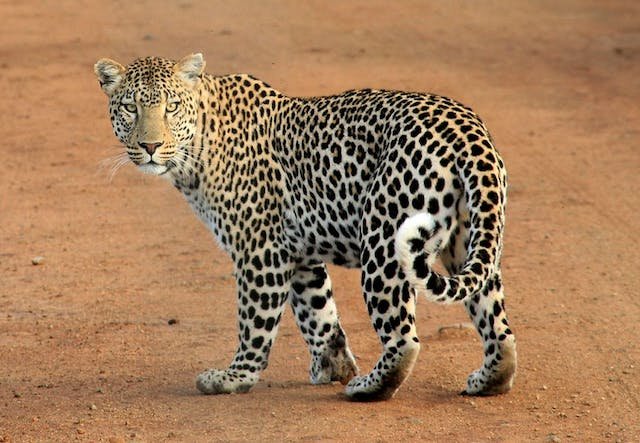Have you ever wondered How Many African Leopards Are Left In World? An estimated population of 11000 African leopards is left. African Leopards have long captured our imagination. However, their population is facing a significant decline due to various threats.
Table of Contents
Characteristics of African Leopards
The African leopard’s coat color changes a lot based on where it lives and what it eats. The coat can be pale yellow, deep gold or tawny, or even black. It has black rosettes on it, and the head, lower limbs, and belly are all spotted with pure black. A male leopard can weigh up to 90 kg (200 lb), but most of the time they weigh only 58 kg (128 lb). Most females weigh around 37.5 kg (83 lb).
African leopards are solitary and elusive creatures, making it challenging to accurately estimate their population. They are primarily nocturnal and spend most of their time on the ground, although they are capable climbers. Leopards are opportunistic hunters, preying on a variety of animals ranging from small rodents to large antelopes.
Ecology and Habitat

African leopards are found in a wide range of habitats, from the dense rainforests of Central Africa to the arid savannas of southern Africa. They are highly adaptable animals and can survive in various landscapes, including mountains, deserts, and even urban areas. Leopards require large home ranges to thrive, making habitat fragmentation a significant threat to their survival.
Threats to African Leopards
The primary threats to the African leopard population include
- Habitat loss and fragmentation.
- Poaching for their fur and body parts.
- Retaliatory killings due to conflict with humans and livestock.
- Trophy hunting.
These threats have led to a significant decline in leopard populations throughout their range.
The Importance of Conservation

African leopards play a crucial role in maintaining the delicate balance of ecosystems. As apex predators, they help regulate prey populations and contribute to biodiversity. Unfortunately, habitat loss, poaching, and human-wildlife conflict pose significant threats to their survival.
Conservation Organizations and Initiatives
Several organizations are working tirelessly to protect African leopards and their habitats. Let’s take a closer look at some leading conservation organizations and initiatives:
- World Wildlife Fund (WWF): WWF focuses on conserving wildlife and their habitats worldwide. They collaborate with local communities and governments to develop sustainable solutions for leopard conservation.
- Panthera: Panthera is dedicated to the conservation of big cats globally. Through scientific research, community engagement, and anti-poaching efforts, Panthera strives to secure a future for African leopards.
- African Wildlife Foundation: The African Wildlife Foundation works to ensure the long-term survival of Africa’s wildlife. They support anti-poaching initiatives, conduct research, and promote habitat conservation to protect African leopards and other species.
How Many African Leopards Are Left In World? Efforts to Protect African Leopards

To safeguard African leopards, a comprehensive approach is required. Conservation efforts include:
- Anti-poaching measures: Strengthening anti-poaching patrols and implementing stricter penalties for illegal wildlife trade are critical to combatting poaching, which remains a significant threat to leopards.
- Habitat preservation: Preserving leopard habitats is crucial. Creating protected areas and promoting sustainable land-use practices help ensure sufficient space and resources for leopard populations.
- Community involvement: Engaging local communities in conservation initiatives is vital. Education and awareness programs, alongside community-based initiatives, foster a sense of stewardship and encourage sustainable coexistence with leopards.
Current Population of African Leopards
Estimating the exact number of African leopards is challenging due to their elusive nature and vast habitats. However, studies indicate that leopard populations are declining in several regions. Geographic distribution varies, with leopards found across sub-Saharan Africa.
Conclusion
The future of African leopards relies on our commitment to conservation. Continued efforts from organizations, governments, and individuals are paramount in protecting these magnificent creatures. By supporting conservation initiatives, raising awareness, and advocating for sustainable practices, we can ensure a brighter future for African leopards and the ecosystems they inhabit.
Also Read: How many Snow Leopards are left in the world?





